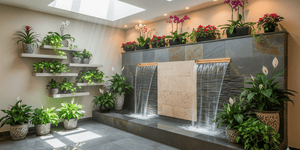Elevate Your Cooking Experience with an Herb Garden

Elevate Your Cooking Experience with an Herb Garden
It's every chef's dream to be able to stroll outside, pick a few sun-ripened herbs, and sprinkle them over a freshly cooked meal. Fresh herbs impart unbeatable flavor and aromas that can elevate even the simplest foods into a gourmet experience, and — even better — they're far easier to grow than you might think. All you need is a little bit of information to get you started on the right path, and before you know it, you'll be enjoying fresh, delicious herbs in the comfort of your own home in no time at all.
What Should I Grow?
The first step in starting an herb garden is determining what herbs you want to grow. This decision will be based on two main pieces of information, namely, what herbs you like to eat and what herbs are easy to grow in a given climate or location. When it comes to deciding what herbs you like to eat, take some time to do a little research. If you love cooking pizza and pasta, Italian-friendly herbs like rosemary and basil may be perfect for you. In contrast, cilantro and mint are used in many Asian curries and sandwiches, and thus may be ideal for a home cook who loves making those dishes. In general, a good rule of thumb is that there's no point in growing an herb if you don't want to eat it, so make your decision carefully.
Where to Place It
Once you have your list of the herbs you want to grow, it's time to think about where you'll place them. An herb garden can be placed outside on a patio just as easily as it can be placed in the window above your kitchen sink — as long as each herb has all the sunlight it needs and is watered consistently, it should remain happy and productive. Be sure to research what light conditions your herbs prefer; for example, parsley can grow in partially shaded areas, while thyme, oregano, and mint prefer full sunlight.
Once you've cleaned off a space for your herb garden so that the herbs have plenty of room to grow, it's time to get started on turning your herb garden dreams into a reality.
How to Get Started
The first step in planting your herbs is finding appropriate containers. There are many kinds of containers you can use, ranging from large pots that contain several different kinds of herbs to trays containing tiny pots that each hold a single type of herb. At this point, function is more important than form: the most important aspect of your herb garden containers is that they contain appropriate drainage, which will allow excess water to escape from the container instead of pooling in the bottom and causing the herb's roots to rot. Whether you opt for terracotta, wood, or even metal containers for your herbs, be sure to drill one or two small holes in the bottom to keep your herbs from drowning.
Additionally, a major part of selecting appropriate containers involves determining which containers can be used to plant specific herbs. For example, mint is an herb that tends to grow voraciously and spread rapidly, taking up all the space in its planter. If you're growing multiple herbs other than mint, it may be ideal to plant mint in its own container so that the other herbs will be able to thrive.
The second step in planting your herb garden is, well, planting the herbs! For this step, you can use either seeds or starter plants; many amateur gardeners prefer using starter plants to save at least two or three weeks of growth time and to generate even more herbs. If you need additional soil for your starter plants, research what types of soil certain herbs prefer. For instance, basil will thrive in nutrient-rich, well-watered soil, whereas oregano requires poor soil that has plenty of drainage. Plant your herbs in their containers, brush off the excess dirt, and get them settled in their new homes.
Once your herb garden is planted, the hard work is over — but your job tending your herbs has just begun. Commit to a consistent watering schedule based on the needs of your specific herbs, allowing any excess water to fully drain out the bottom of each pot, and be sure to rotate pots occasionally if one side gets far more sun than the others. Finally, don't forget to enjoy the fruits of your labor: not only does harvesting herbs from your plants taste delicious, but it also helps to promote new growth. It's an easy way to ensure that your herb garden looks (and tastes) its best for years to come.
Eat and Enjoy
Once you've set up your herb garden and committed to a consistent watering schedule, there's very little else you need to do other than sit back, relax, and enjoy your fresh herbs! A very simple recipe that beautifully showcases basil, an herb that is as easy to grow as it is delicious, is the Italian classic, Caprese salad. Be sure to pick plenty of fresh basil to enjoy its vibrant summer flavors!
Caprese Salad (serves 8)
Ingredients:
- 3 ripe tomatoes, sliced
- 12 oz mozzarella, sliced
- Olive oil, for drizzling
- Balsamic vinegar, for drizzling
- Salt and pepper
- Large bunch fresh basil
Layer the tomato and mozzarella slices on a large platter, alternating them as you go. Tuck the basil leaves between the slices of tomato and cheese. Drizzle entire dish with olive oil and balsamic vinegar, and sprinkle with salt and pepper. Serve immediately and enjoy!





